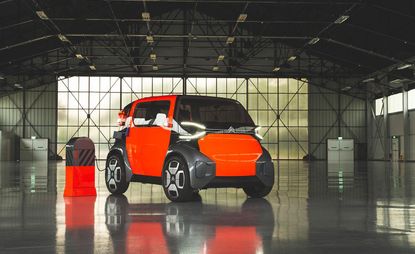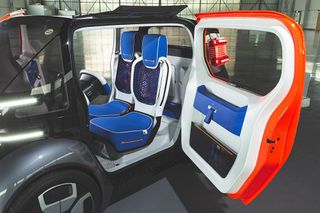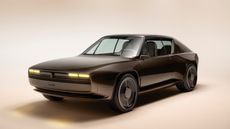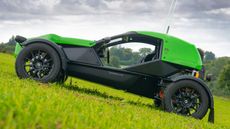Citroën Ami One considers the future of the urban commute
An all-electric car made from novel sustainable materials

In the early sixties, Citroën produced a car name Ami. It was conceived as a more adult and urban alternative to the French marque’s popular tiny 2CV. The Ami 6 and 8 ran for two generations, and were nicknamed 3CV for their boosted power. Today we’re about to experience an entirely different ‘ami’. In the spirit of both cars, Citroën is presenting the Ami One, a concept conceived to gauge the possibilities of the urban commute in a car with an approximate footprint of the 2CV, but with a thoroughly modern outlook.
The original deux chevaux was famously designed to help motorise French farmworkers in the 1930s, a time when horses and carts were still the primary mode of rural transport. The Ami One conceptually does the same, albeit for the modern, metropolitan worker. The study vehicle offers a glimpse into how mobility might look in our ever-sprawling cities in the not too distant future. Citroën says the technology is all possible today, and that a similar mobility solution could possibly happen in the next five years.

So, what is it like to experience? The car we’re testing is purely a prototype, so the feel and drive are not as polished as a fully-fledged production car. That said, the short run in the confines of a controlled environment is fun and easy – everything on this little friend is considered and intuitive.
The Ami One is fully electric, and it seats two adults comfortably offering plenty of room in front of the passenger and in the rear for bags and shopping. The design is more akin to that of a personal gadget than a motor car, with a simple cubic form in which you sit upright and tall. Some exciting ideas for automotive come into play too. For instance, the doors are made of identical panels – rear-hinged for the driver and front-hinged for the passenger – to minimise the number of parts produced and cut manufacturing costs. Similarly, the front and rear bumpers are the same parts – only positioned differently. Then, for a dose of extra cost-cutting and an unfussy touch, the Citroën double chevron logo is simply a flat sticker.

‘We debated this at first,’ says Pierre Leclercq Citroën’s new design director as he sits in the passenger seat, ‘but it felt like the right thing to do with this car. Our design approach was to be restrained, and we looked to product design and manufacturing processes for this car’. The Ami interior continues this modest approach, pared down to the basic needs of short distance travel, without looking too austere. This is mainly due to the pop colour scheme and modern textiles. Leclercq says novel sustainable materials will be explored if this car is to get the green light. The driver seat adjusts back and forth, and tilts to make room for luggage (a set of which is designed by the team to blend with the interior). There are no electric window winders; you have to manually operate these, the slim wing mirrors and canvas roof.
The Ami One is designed to be a shared, hop-on-and-off, or privately-owned transport idea for young urbanites. Your smartphone essentially acts as the central interface – place it behind the steering wheel and it provides the info and music through the Bluetooth speaker. If you change car, your settings come with you. Citroën has rightly identified that the next generation is unlikely to love the motor car as much as their forebears. What matters is simplicity and personality. As a hire car, the Ami One is easy to clean and maintain, with on-board elements made of materials inspired by garden furniture and public transport. If, however, someone wishes to buy an Ami One for themselves, there would be the option to remove these panels and add your own personal touch; Leclercq is keen to encourage this personal artistic freedom.

The mechanics are also straightforward. The battery sits under the occupants’ floor and a small electric motor drives the rear wheels. Electric range, we are told, is somewhere around 100 miles with charging predicted to take a couple of hours. What’s more, the Ami conforms to quadricycle regulations, which means it requires the same licensing as a scooter, and with a top speed of 28mph, in some countries it can be driven by under seventeens without a driving licence.
There’s something else. As we start to drive, the Ami One ‘hums’ ‘Free to Feel’, a track composed by Alex Jaffray and Gilles Facérias especially for this car. With new regulation insisting that silent electric cars have a sound to warn other road users, Leclercq says Citroën is exploring its sonic options for an electrified future. Surprisingly, the subtle track seems to work well.
Alongside parent company Groupe PSA, Citroën is fully committed to electrification. This Ami One has egalitarian ambitions. It provides mobility for young urbanites in any city around the world. The Ami has some maturing to do, but as a concept it is an inspired product, a 2CV for a new generation of drivers.
INFORMATION
Wallpaper* Newsletter
Receive our daily digest of inspiration, escapism and design stories from around the world direct to your inbox.
A writer and editor based in London, Nargess contributes to various international publications on all aspects of culture. She is editorial director on Voices, a US publication on wine, and has authored a few lifestyle books, including The Life Negroni.
-
 Midtown Manhattan restaurant Ánimo! takes its cues from Mexican morning rituals
Midtown Manhattan restaurant Ánimo! takes its cues from Mexican morning ritualsDesigner Jordana Maisie creates a minimalistic yet referential setting for Ánimo!
By Adrian Madlener Published
-
 Leica Cine Play 1 brings premium style and tech to the world of home cinema
Leica Cine Play 1 brings premium style and tech to the world of home cinemaLeica compresses its meticulous optic know-how into the ultra-compact Cine Play 1 4K projector
By Jonathan Bell Published
-
 Welcome to the party: the Wallpaper* Entertaining Issue is on sale now
Welcome to the party: the Wallpaper* Entertaining Issue is on sale nowWelcome to the December 2024 Wallpaper* Entertaining Issue: from haute hosting to decadent dressing and a rendez-vous with Italy's powerhouse design families
By Bill Prince Published
-
 Looking for a long-range luxury EV that’s a true Tesla alternative? Welcome to the Lucid Air
Looking for a long-range luxury EV that’s a true Tesla alternative? Welcome to the Lucid AirWe drive the Lucid Air, the high-performance Californian EV that’s a welcome leftfield choice in a sea of Musk-mobiles. Vote Lucid!
By Guy Bird Published
-
 All hail the arrival of true autonomy? On Tesla’s proposed Robotaxi and techno-insecurity
All hail the arrival of true autonomy? On Tesla’s proposed Robotaxi and techno-insecurityTesla’s new marketing push predicts a future of robot cabs, automated buses and autonomous home androids. We already want to get off
By Jonathan Bell Published
-
 We report from the theatrical, laser-lit launch of Lynk & Co’s first European EV, the 02
We report from the theatrical, laser-lit launch of Lynk & Co’s first European EV, the 02In the future, will we treat cars like streaming services and simply subscribe to them? That’s one way that Lynk & Co envisages customers getting into their cars, including the new 02 EV
By Jonathan Bell Published
-
 We make off with a MOKE and experience the cult EV on the sunny backroads of Surrey
We make off with a MOKE and experience the cult EV on the sunny backroads of SurreyMOKE is a cult car with a bright future. Wallpaper* sat down with the company's new CEO Nick English to discuss his future plans for this very British beach machine
By Jonathan Bell Published
-
 The mibot is a tiny single-seater ‘mobility robot’ for traversing Japan’s crowded city centres
The mibot is a tiny single-seater ‘mobility robot’ for traversing Japan’s crowded city centresJapan is the undisputed centre of compact car culture, and KG Motors' new mibot is one of a new wave of micro-EVs that look set to take the country’s cities by storm
By Jonathan Bell Published
-
 SM Tribute by DS Automobiles marks ten years of the brand and signals bold things to come
SM Tribute by DS Automobiles marks ten years of the brand and signals bold things to comeThis spectacular concept car pays homage to one of the most iconic Citroën designs of all time, the 1970 SM by Robert Opron
By Jonathan Bell Published
-
 Ora-ïto transforms the Renault 17 into a futuristic yet retro-tinged vision
Ora-ïto transforms the Renault 17 into a futuristic yet retro-tinged visionThe R17 electric restomod x Ora-ïto is the fourth in Renault's series of designer-led reimaginings of iconic models from its past. We think it's the best of the lot
By Jonathan Bell Published
-
 Specialist car-maker Ariel explorers the power of electrification with the E-Nomad concept
Specialist car-maker Ariel explorers the power of electrification with the E-Nomad conceptThe Ariel E-Nomad is an all-electric, go-anywhere sports car concept for the dedicated enthusiast. Could it be the shape of sporting EVs to come?
By Jonathan Bell Published